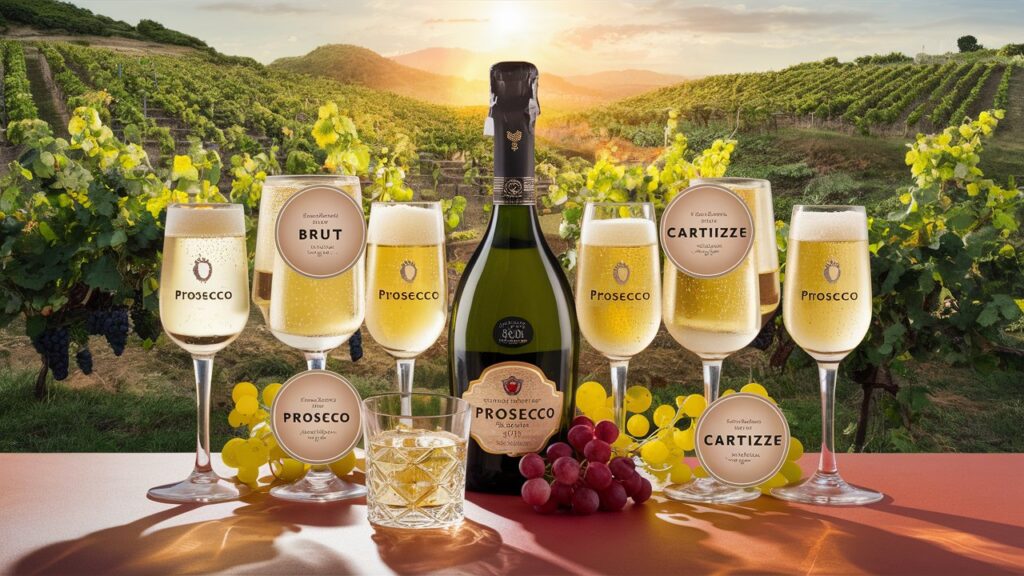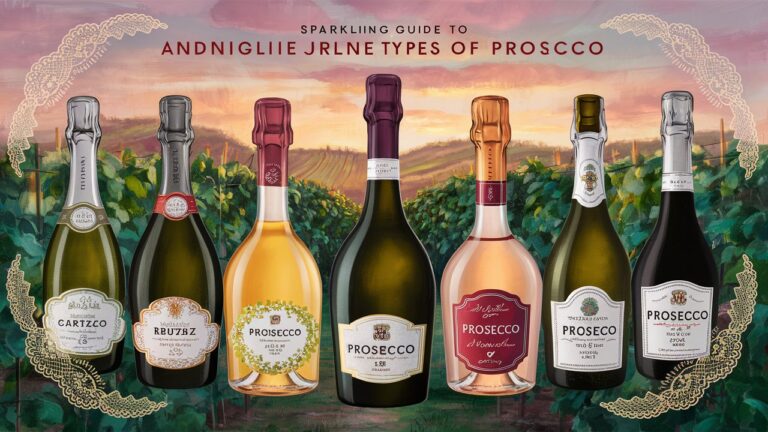Introduction
Prosecco, Italy’s beloved sparkling wine, has captivated palates worldwide with its effervescence, versatility, and approachable flavor profile. Originating from the Veneto and Friuli Venezia Giulia regions, Prosecco is crafted primarily from the Glera grape and offers a spectrum of styles to suit every occasion. Whether you’re a casual sipper or a connoisseur, understanding the different types of Prosecco—from sweetness levels to production methods—can elevate your appreciation of this iconic bubbly. In this guide, we’ll explore the nuances of Prosecco categories, including DOC/DOCG classifications, sweetness designations, and unique sub-regional expressions like Cartizze. By the end, you’ll be equipped to choose the perfect bottle for celebrations, pairings, or everyday indulgence.
1. Understanding Prosecco DOC and DOCG: The Foundation of Quality
Prosecco’s quality and authenticity are governed by Italy’s strict appellation system, which includes Denominazione di Origine Controllata (DOC) and Denominazione di Origine Controllata e Garantita (DOCG). Prosecco DOC encompasses a broad geographic area spanning nine provinces in northeastern Italy, allowing for larger-scale production while maintaining baseline standards for grape sourcing and winemaking techniques. DOC Prosecco is typically fresh, fruity, and affordable, making it a crowd-pleasing choice for aperitifs or casual gatherings.
In contrast, Prosecco DOCG represents the pinnacle of quality, limited to two prestigious regions: Conegliano Valdobbiadene and Asolo. These hilly terrains yield grapes with greater complexity due to optimal sun exposure and mineral-rich soils. Wines from these areas often showcase refined acidity, floral aromas, and a creamy mouthfeel. The DOCG label guarantees rigorous production standards, including hand-harvesting and lower yields, ensuring a premium experience.
2. Sweetness Levels: Brut, Extra Dry, and Dry
One of Prosecco’s most distinctive features is its range of sweetness levels, which cater to diverse preferences. The three primary categories are Brut, Extra Dry, and Dry, each defined by residual sugar content.
Brut Prosecco (0–12 grams of sugar per liter) is the driest style, celebrated for its crisp, zesty character. Notes of green apple, citrus, and white peach dominate, balanced by vibrant acidity. Brut’s refreshing profile makes it ideal for pairing with seafood, light salads, or as a standalone aperitif.
Extra Dry Prosecco (12–17 grams of sugar) strikes a harmonious middle ground, offering subtle sweetness without cloying richness. Its flavors of ripe pear, honeysuckle, and almond appeal to those who enjoy a rounder, softer finish. This versatile style pairs beautifully with spicy Asian cuisine or creamy cheeses like Brie.
Dry Prosecco (17–32 grams of sugar) is the sweetest category, though still lighter than dessert wines. Its lush stone fruit and tropical notes complement fruit-based desserts or brunch dishes like pancakes. Despite its name, “Dry” refers to historical terminology rather than actual dryness.
3. Frizzante vs. Spumante: Bubbles That Define Texture
Prosecco’s effervescence varies between Frizzante (semi-sparkling) and Spumante (fully sparkling), impacting both texture and occasion suitability.
Spumante Prosecco undergoes a secondary fermentation in stainless steel tanks (Charmat method), producing lively, persistent bubbles and a frothy mousse. This style, with its celebratory flair, dominates global markets and is perfect for toasting or pairing with rich dishes like fried calamari.
Frizzante Prosecco has gentler carbonation, achieved through a shorter fermentation. Its lighter fizz and lower pressure (2.5 atmospheres vs. Spumante’s 3+) create a playful, easy-drinking experience. Frizzante shines in casual settings, such as picnics or afternoon sipping, and pairs well with delicate appetizers like bruschetta.

4. Prosecco Rosé: The Newcomer with a Pink Twist
Introduced in 2020, Prosecco Rosé blends Glera with 10–15% Pinot Nero (Pinot Noir), yielding a salmon-pink hue and red fruit accents. This style must undergo a minimum 60-day secondary fermentation, enhancing its structure and complexity. Expect vibrant notes of strawberry, raspberry, and rose petals, balanced by Prosecco’s signature freshness. Rosé’s versatility bridges the gap between traditional Prosecco and sparkling rosé wines, making it a hit for summer parties or romantic dinners.
5. Cartizze: The “Grand Cru” of Prosecco
Nestled within the Conegliano Valdobbiadene DOCG, the Cartizze subzone is a 260-acre hillside revered as Prosecco’s crown jewel. Its steep slopes and unique microclimate yield grapes with unparalleled concentration and aromatic intensity. Cartizze Prosecco (often labeled Superiore di Cartizze) is typically a Dry or Extra Dry style, bursting with flavors of apricot, acacia honey, and vanilla. Limited production and labor-intensive harvesting make Cartizze bottles pricier, but their luxurious depth justifies the splurge for special occasions.
6. Sustainable and Organic Prosecco: A Growing Trend
As eco-consciousness rises, many Prosecco producers are adopting organic and sustainable practices. Organic Prosecco eschews synthetic pesticides, relying on natural compost and biodiversity to nurture vines. Meanwhile, sustainable wineries implement water conservation, solar energy, and lightweight bottles to reduce their carbon footprint. These wines often highlight terroir-driven flavors, appealing to environmentally minded consumers.
Conclusion
From the crisp Brut of DOC regions to the opulent Cartizze of DOCG hillsides, Prosecco’s diversity ensures there’s a bottle for every taste and moment. Understanding its classifications, sweetness levels, and styles empowers you to navigate wine lists and shelves with confidence. Whether you’re celebrating milestones or savoring quiet evenings, Prosecco’s joyful effervescence and approachable charm make it a timeless choice. Raise a glass to exploration—your next favorite Prosecco awaits!
Frequently Asked Questions (FAQs)
Q: What’s the difference between Brut and Extra Dry Prosecco?
A: Brut is the driest, with 0–12g sugar, while Extra Dry has 12–17g, offering a touch of sweetness.
Q: Why is Prosecco DOCG more expensive than DOC?
A: DOCG wines come from premium, hillside vineyards with stricter production rules, yielding higher quality and limited supply.
Q: Can Prosecco Rosé age like traditional Prosecco?
A: Like most Proseccos, Rosé is best enjoyed young (within 1–3 years) to preserve its fresh fruit character.
Q: What foods pair well with Cartizze Prosecco?
A: Its richness complements foie gras, lobster, or almond-based desserts.
Q: Is all Prosecco vegan?
A: Not necessarily—some wineries use animal-derived fining agents. Check labels for vegan certifications.
